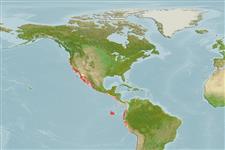>
Scombriformes (Mackerels) >
Trichiuridae (Cutlassfishes) > Lepidopodinae
Etymology: Lepidopus: Greek, lepis = scale + Greek, pous = foot (Ref. 45335); fitchi: Named in honor of the late John Fitch, indefatigable student of California fishes (Ref. 12696).
More on authors: Rosenblatt & Wilson.
Environment: milieu / climate zone / depth range / distribution range
Οικολογία
Θαλασσινό(ά) βενθοπελαγικό; εύρος βάθους 100 - 500 m (Ref. 6181), usually 100 - 250 m (Ref. 9351). Deep-water; 46°N - 17°S, 128°W - 75°W (Ref. 6181)
Eastern Pacific: Cape Kiwanda, Oregon, USA to the Gulf of California; then from 5°N to southern Peru.
Μέγεθος / Βάρος / Age
Maturity: Lm ? range ? - ? cm
Max length : 210 cm SL αρσενικό/απροσδιόριστο; (Ref. 9351); common length : 150 cm SL αρσενικό/απροσδιόριστο; (Ref. 9351); μεγ. δημοσιευμένο βάρος: 1.4 kg (Ref. 6181)
Short description
Μορφολογία | Μορφομετρία
Μαλακές ραχιαίες ακτίνες (συνολικά): 78-87; Εδρικές άκανθες 2; Μαλακές εδρικές ακτίνες: 41 - 50; Σπόνδυλοι: 84 - 93. Upper head profile slightly convex, rising gently from snout to dorsal-fin origin. Orbits nearly touching dorsal profile; interorbital space slightly concave. Pelvic fins reduced to 1 scale-like spine and 1 - 2 tiny rays. Pyloric caeca 16 - 18. Color of body is black or brown with a silvery shine along the abdomen.
Benthopelagic on the continental shelf and slope, up to a depth of 400 m or more; generally found over sandy bottoms at a depth between 100 and 250 m (Ref. 9351). During cold season, it is often seen near the surface at nights when the moon is full (Ref. 9351). May also be encountered in surge zones and sometimes observed to be beached in large numbers by the shore (Ref. 9351). A schooling species which feeds on cephalopods, euphausiids and small fishes, including Engraulis mordax and juvenile Merluccius productus. Marketed fresh and frozen (Ref. 9351). Excellent food fish, also processed into fish meal and oil (Ref. 9351).
Life cycle and mating behavior
Γεννητική Ωρίμανση | Αναπαραγωγή | Γεννοβολία | Αβγά | Γονιμότητα | Προνύμφες
Nakamura, I. and N.V. Parin, 1993. FAO Species Catalogue. Vol. 15. Snake mackerels and cutlassfishes of the world (families Gempylidae and Trichiuridae). An annotated and illustrated catalogue of the snake mackerels, snoeks, escolars, gemfishes, sackfishes, domine, oilfish, cutlassfishes,. scabbardfishes, hairtails, and frostfishes known to date. FAO Fish. Synop. 125(15):136 p. (Ref. 6181)
IUCN Red List Status (Ref. 130435)
Threat to humans
Harmless
Human uses
αλιεία: περιορισμένης εμπορικότητας
Περισσότερες πληροφορίες
Κοινά ονόματαΣυνώνυμαΜεταβολισμόςΘηρευτέςΟικοτοξικολογίαΑναπαραγωγήΓεννητική ΩρίμανσηΓεννοβολίαΣυναθροίσεις γεννοβολίαςΓονιμότηταΑβγάEgg development
Age/SizeΑύξησηLength-weightLength-lengthLength-frequenciesΜορφομετρίαΜορφολογίαΠρονύμφεςΔυναμική προνυμφώνΣτρατολόγησηΑφθονίαBRUVS
ΑναφορέςΥδατοκαλλιέργειεςΠροφίλ υδατοκαλλιέργειαςΣτελέχοιΓενετικήElectrophoresesΚληρονομικότηταΑσθένειεςΜεταποίησηNutrientsMass conversion
ΣυνεργάτεςΦωτογραφίεςStamps, Coins Misc.ΉχοιΣιγκουατέραΤαχύτηταΚολυμβητικός ΤύποςΕπιφάνεια βραγχίωνOtolithsΕγκέφαλοιΌραση
Εργαλεία
Special reports
Download XML
Διαδικτυακές πηγές
Estimates based on models
Preferred temperature (Ref.
123201): 8.2 - 15.4, mean 12.8 °C (based on 70 cells).
Phylogenetic diversity index (Ref.
82804): PD
50 = 0.5156 [Uniqueness, from 0.5 = low to 2.0 = high].
Bayesian length-weight: a=0.00275 (0.00105 - 0.00724), b=3.06 (2.83 - 3.29), in cm total length, based on LWR estimates for this (Sub)family-body shape (Ref.
93245).
Τροφικό Επίπεδο (Ref.
69278): 4.1 ±0.59 se; based on food items.
Ελαστικότητα (Ref.
120179): Χαμηλό, ελάχιστος χρόνος για διπλασιασμό πληθυσμού 4,5 - 14 έτη (Preliminary K or Fecundity.).
Fishing Vulnerability (Ref.
59153): Very high vulnerability (90 of 100).
Nutrients (Ref.
124155): Calcium = 11.5 [5.3, 23.6] mg/100g; Iron = 0.289 [0.135, 0.650] mg/100g; Protein = 17.2 [15.5, 18.8] %; Omega3 = 0.209 [0.095, 0.481] g/100g; Selenium = 30.3 [11.9, 77.8] μg/100g; VitaminA = 8.03 [1.37, 41.90] μg/100g; Zinc = 0.26 [0.17, 0.43] mg/100g (wet weight);
